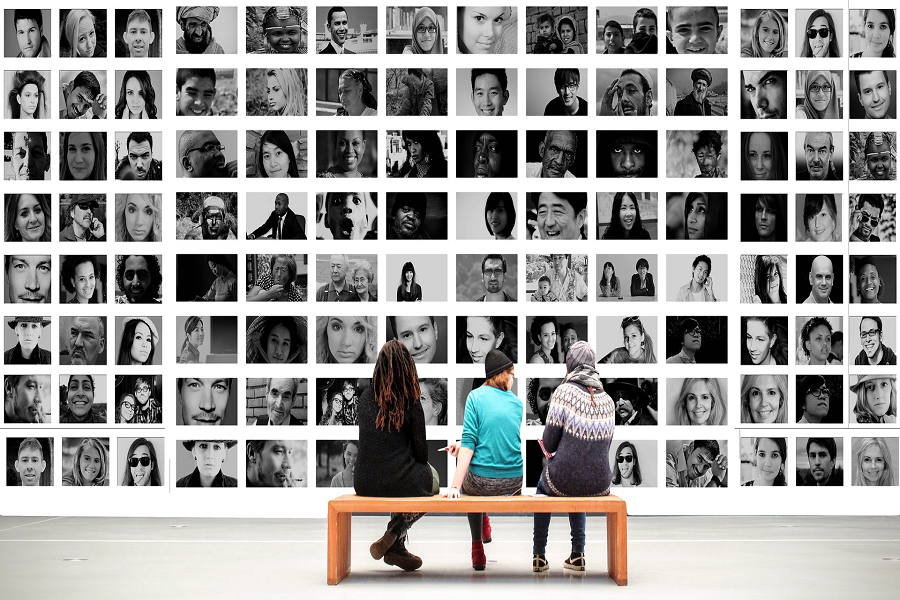"HR can help companies leverage D&I to reimagine people management and elevate brand-loyalty among employees, customers and investors."
Learn about the latest diversity & inclusion trends emerging in 2020.
Promoting diversity and inclusion (D&I) in the workplace is a critical element of talent management as it cultivates employee engagement and enhances the employee experience. In an inclusive culture, team members feel valued, respected and accepted as individuals—and are therefore encouraged to fully participate and contribute as their authentic, unique selves. A diverse staff provides companies with different perspectives and new skills that infuse company culture with innovation and creativity, which are key to thriving in digital transformation.
Cultural evolution, emerging markets, advancing technology, generational differences, widespread immigration and a widening skills gap are contributing to an increasingly complex corporate environment that challenges old processes and necessitates new ways of building a workforce.
These forces—while presenting challenges for HR leaders in recruiting, developing and retaining top talent—also open doors. Innovation comes from all corners of the globe. Strong D&I improves a company’s performance because it opens new talent pools and expands points of view and experiences. Businesses that do not recruit from diverse talent pools are at risk of missing out on qualified candidates and incurring higher recruitment costs.
Why Diversity & Inclusions Matters
D&I progress not only helps organizations fill positions with qualified candidates more efficiently—it also raises the employer brand, which is becoming increasingly important for attracting the right talent. According to research from Glassdoor, 67% of active job seekers said a diverse workforce is important when considering job offers and 57% of employees think their companies should be more diverse.
Having a diverse, multilingual workforce from varying ethnic backgrounds can also be helpful for companies that want to expand or improve operations in new markets locally, regionally, nationally and internationally. As millions of new internet users sign online each year for the first time, companies have an unprecedented opportunity to communicate and captivate new customers and draw in talent. D&I can help accomplish this, as diverse companies are 70% more likely to capture new markets.
A large-scale shift toward diversity and inclusion workplace policies can make waves around the world. For example, the World Economic Forum has projected that correcting gender segregation in employment and developing women’s entrepreneurship could increase productivity globally by as much as 16%.
Trending Now: Diversity & Inclusion
The compelling business case for D&I means that more companies will adopt stronger policies and become more adept at integrating a myriad of individuals into one cohesive workforce. D&I will therefore become the norm rather than the exception.
Keeping a strong pulse on the D&I trends emerging in the workplace can help a company stay a beat ahead of the competition and prepare for the future of work.
1. Deploying artificial intelligence (AI) technology to remove unconscious bias.
Unconscious bias has become a hot topic of the D&I conversation in HR, as companies make strides toward becoming more diverse and inclusive. Companies cannot afford to ignore implicit bias for it has serious consequences on the employee experience, whether in hiring/recruitment, employee feedback, performance reviews, or development. The Center for Talent Innovation found that employees at large companies who perceive bias are:
· Three times as likely to plan to leave their employers within the year.
· More than twice as likely to have withheld ideas or solutions in the past six months at work.
· Five times as likely to speak about their company in a negative manner on social media.
Even if a company commits itself to fully eliminating unconscious bias, it still proves to be difficult because these predispositions operate automatically and act without us even knowing it. All humans, whether we notice it or not, engage in unconscious bias to some degree. It’s often involuntary and rooted in the brain. Furthermore, there are far too many biases to manually remove them from our decision-making processes.
Because unconscious bias is an ingrained human trait, some experts suggest that the best way to overcome it is via non-human solutions—such as artificial intelligence (AI). A notable feature of AI in HR technology is its potential to mitigate the effects unconscious bias companies face in the hiring and development process. With AI, candidates are sourced, screened and filtered through large quantities of data. The programs combine data points and use algorithms to identify who will likely be the best candidate. These data points are looked at objectively, completely removing the biases, assumptions and oversight that humans are naturally hindered by.
AI for human resource systems can be also programmed to automatically ignore a candidate’s demographic information, such as gender, race and age. It can take a step beyond protecting the basic demographic information and disregard other details that may indicate racial or socioeconomic status, such as school names and zip codes.
When it comes to assessment and development, L&D programs can be strengthened with machine learning to identify high-potential employees with the skills and qualifications the company needs. Strikingly, it has been found that the employees ranked highest by the machine learning software aren’t usually those on the promotion track. Instead these high potential employees may exhibit qualities such as introversion that find them being overlooked when undergoing traditional methods of assessment.
2. Using data to assess D&I climate, identify focus areas & quantify the success of initiatives.
Among the challenges for implementing D&I initiatives are knowing where to begin, how to focus efforts and how to measure success. When seeking a buy-in from leadership for a diversity program, it is important that the HR department sets out a strategy for quantifying its ROI. To satisfy this, many companies are now turning to data-driven ways of assessing the D&I climate, focusing efforts and determining if an initiative was successful.
Before implementing any D&I initiative, the company’s starting condition—its current D&I environment—should be diagnosed. D&I is a vast realm so narrowing down focus areas can help a company in implementing or improving practices. The diagnosis can help identify focus areas and drive diversity initiatives forward in a tailored way that will fill the company’s distinct gaps.
To gather useful D&I data, some companies conduct regular employee engagement surveys, asking questions that focus on company culture and inclusion. From the onset, these surveys, especially when done consistently, can serve as a barometer of the company’s D&I culture since it is based on first-hand feedback directly from employees.
It is also key to evaluate employee data, such as turnover rates, promotion and salary. Some sample metrics that can be used to assess D&I practices include for each employee: the velocity of mobility (which is the length of time it takes to hire, promote and move up within the company), pathways for employees, percentage of diverse employees with mentors, results of mentorship in terms of career progression and employee engagement. This data can help uncover systemic issues like a gender pay gap. Companies can also look across employee reviews online, such as on Glassdoor, or conduct a social media audit to detect if there is any evidence of bias.
After all key areas for improvement have been identified, there must be organizational consensus on how to measure changes. Some companies rely on retention and attrition rates of different groups as an indicator for success. When implementing D&I training, it is helpful to perform employee surveys both prior and after to gauging the program’s success.
Storing data from evaluations and all D&I initiatives can help measure changes along the way. The end goal of a more inclusive, diverse team is of course central to D&I but there should also be methods of measuring success along the journey. Each company is different and there will never be a one-size-fits-all approach to D&I but consistent data collection can help companies implement, modify and quantify their success.
3. Increased leadership accountability & support for D&I programs.
Corporate leadership is recognizing that a solid D&I strategy is not merely a “nice-to-have” add-on carried out solely by the HR department but is instead a business imperative in today’s competitive landscape. Among the best practices for D&I implementation are executive buy-in and a strategic emphasis on D&I as a valued competitive advantage. Some companies are taking it a step further and modifying the structure of an organization’s leadership to enrich its approach to D&I.
In a top down approach, some companies are making headway on D&I by creating an executive role in the form of a chief diversity and inclusion officer. The D&I executive can outline goals, establish targets, identify key improvement areas and then lead the organization through the steps of meeting goals. While this person interfaces with all areas of the organization in various capacities, the D&I’s department takes ownership and spearheads D&I initiatives.
An employee-led grassroots approach forms a decentralized company-wide D&I council that draws on feedback directly from employees. While it still requires executive buy-in, the council’s reach is distributed through the entire workforce. The council appoints representatives from various departments or segments of a company and meets regularly to improve the company’s D&I culture as it pertains to recruitment, engagement and development.
Some companies might opt for a hybrid approach to D&I leadership, which would involve appointing a D&I-specific executive and a D&I council. Instead of being solely led by employees, the D&I council is supported by the HR department and guided by representation from both the D&I executive and employees. Initiatives are cooperatively strategized and outlined by the D&I executive, HR and employees. The three groups agree upon how initiatives will be spearheaded and what role each group will play in their execution.
4. Interview standardization will continue & reduce bias.
Inconsistent recruitment practices will yield inconsistent (or, even worse, illegal) hiring results and may also open floodgates for unconscious bias in hiring processes. For quality and compliance, HR should have policies in place that ensure the hiring process is standardized from the time they list the job all the way through to when the hired employee steps in the door (or signs online if they’re remote) for their first day of work. Establishing and implementing hiring best practices provides a company’s recruiters with control and guidance for hiring. This type of standardization enhances transparency, allows for a fair comparison of candidates and reduces the risk of violating applicable labor laws. It also helps promote a company’s E&D profile.
Striving for behavioral interviewing methods is an ideal strategy because a person’s behavior is an indication of future performance, especially when it comes to soft skills. According to research from LinkedIn, 57% of HR professionals struggle to assess candidates’ soft skills while 80% report that soft skills are increasingly important to company success. This makes sense because soft skills are one area where automation and AI cannot fully compete with humans.
Many companies want the initial introduction with a candidate to be as blind as possible. This might mean starting out with a phone interview, which will eliminate visually-based unconscious bias upfront. Some companies are taking it a step further to accomplish the “blind interview,” using voice modulation apps for technical interviews so the interviewer won’t know the candidate’s gender or be able to pick up on any accent that might distinguish background attributes of the candidate.
Behavioral interviewing seeks to uncover how an individual will react in critical job situations and can potentially provide more insight about a candidate’s qualification for the job than what is written on their resume or what you hear when you ask a candidate about their professional background. These questions could start with, “What would you do in…” or, “Tell me about a time when you…”
Using an example of a customer service representative interview, the interviewer might present prospective candidates with a hypothetical customer situation and have them explain their approach to addressing it.
Asking the typical behavioral interviewing questions reduces the risk of legal or ethical pitfalls in the interview questions. Formally planning and asking all candidates the same questions saves time and prevents duplicate questions from being asked by multiple interviewers (unless intentionally done, so as to confirm consistency in the candidate’s response). This brings up another key point of having multiple people interview each candidate when possible. Engaging multiple interviewers can help overcome unconscious bias in interviews and offer a wider perspective for determining a candidate’s standing.
However, even behavioral interview questions can be answered untruthfully by candidates. Pre-employment assessments can validate or negate the data derived from an interview. There are many options available to companies for hiring assessment tools that quantify and use objective, impartial data to evaluate candidates. Results from pre-employment assessments can provide an accurate snapshot of a candidate's strengths and weaknesses. The results can even be input to create hiring benchmarks that candidates can be compared to.
5. Diversity & inclusion will be embraced across products & services for customers.
D&I has gone mainstream. In the age of customer-centricity, there is mounting pressure on companies across industries to launch inclusive products and solutions that meet the needs of all customers. The 2019 World Economic Forum Annual Meeting identified ‘empathy for the end-user’ as a key competitive advantage for succeeding in the digital age. In the age of digital transformation, companies will have to become more accessible to wider customer bases—and invoke messages and values that resonate with audiences across cultural and geographic boundaries.
According to LinkedIn, nearly half of employers said that they emphasize the importance of diversity to better represent their customers. This number is likely to grow as customers, who are increasingly accustomed to personalized products and services, will expect D&I to be embedded in the customer experience. Meanwhile, 70% of millennials are more likely to choose one brand over another brand if that brand demonstrates D&I in terms of its promotions and offers.
As an industry that has been spearheading corporate D&I efforts for years, HR has deep expertise and can play a prominent role in leading the customer experience transformation. As companies look to amplify their market-relevance, HR departments will be charged with strategically staffing companies in ways that enrich the D&I profile and foster greater connections with customers.
The moral case for building fairer and more inclusive workplaces is clear: people matter and organizations have an ethical and legal obligation to ensure their people management strategies do not disadvantage any groups. But equally important, D&I has evolved from being an HR-led initiative to being one that is reverberated to all corners of a company as a key business strategy.
As global unemployment reaches its lowest point in 40 years and we enter an employment economy, the hiring landscape is only becoming more competitive. In this landscape, D&I is fast becoming one of the most powerful tools a business has. By keeping pace, HR can help companies leverage D&I to reimagine people management and elevate brand-loyalty among employees, customers and investors.










